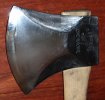- Joined
- Mar 8, 2008
- Messages
- 26,079
Of course they were made by smiths. I think they started when users brought their worn axes with short toes and heels back to the smith for repair. The fastest repair was simply to move some metal forward from the cheeks to the heel and toe. And Voila! The beveled axe was born. Users quickly realized that the new shape was better than the old. And a revolution in axes was made.
I cannot imagine a way that a smith would be able to move metal from the cheeks all the way to the heel and toe of the bit. The fastest way to fix a worn toe would have been to beat the now-thickened edge shoulder to thin it out and push the edge forward.











